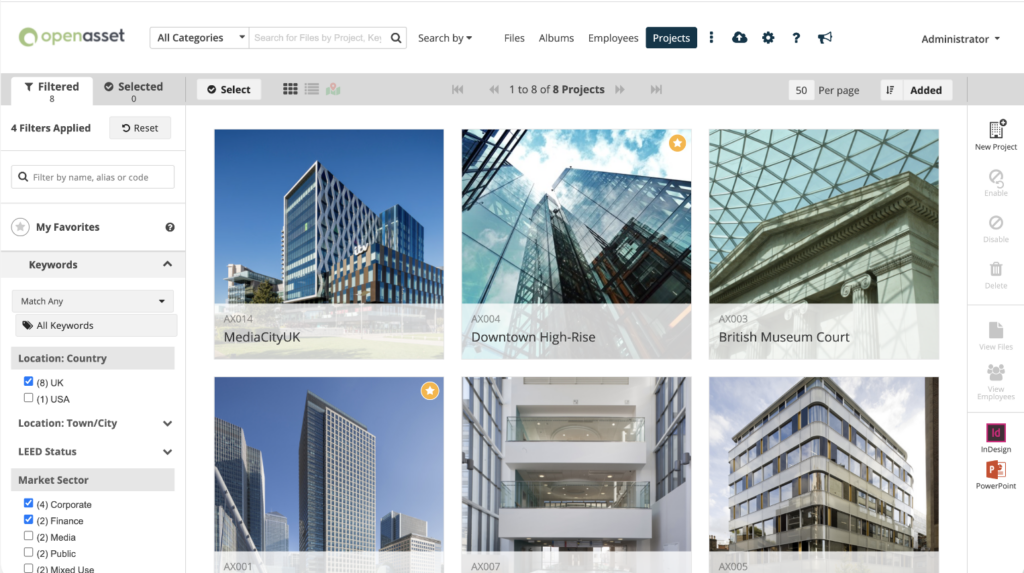The construction industry is set for significant transformation in 2024, driven by innovative technologies, sustainable practices, and evolving market dynamics. From advancements in digital tools to a stronger focus on environmental responsibility, the landscape is rapidly changing and adopting new construction industry trends.
In this blog, we’ll explore the top 23 construction industry trends shaping the future of construction, offering insights into how industry professionals can navigate and leverage the latest construction industry trends to stay competitive and successful.
1. Green Building and Sustainability
In 2024, sustainability is a cornerstone of the construction industry. Companies are adopting eco-friendly practices by using green building materials and integrating energy-efficient technologies.
Nearly half of all respondents in the construction and design sectors expect the majority of their projects to be environmentally sustainable by the end of this year. Furthermore, 90% of industry respondents believe a shift towards environmental sustainability is on the rise.
This shift is driven by regulatory demands and a strategic business imperative, as construction clients increasingly seek environmentally responsible projects. From design to completion, sustainable practices are becoming embedded in the construction process.
Designers and builders are focused on creating structures that are both eco-friendly and energy-efficient, using non-toxic materials that benefit both the environment and the occupants’ quality of life.
Green construction goes beyond just reducing a building’s carbon footprint; it includes using sustainable resources and construction models to optimize resource use.
Here are some key benefits of green building:
- Energy Efficiency: Buildings are significant contributors to CO2 emissions, accounting for nearly 40% of global energy-related carbon output. Through green construction, energy consumption and greenhouse gas emissions are substantially reduced.
- Water Conservation: Sustainable building practices include measures that minimize water use.
- Health and Safety: Using non-toxic, sustainable materials enhances the living conditions within buildings, contributing to better health outcomes for occupants.
Despite these advantages, sustainable features often remain viewed as luxuries. However, this perception is expected to shift over the next decade as green technology and sustainable construction practices become more mainstream.
Lastly, as of 2019, renewable energy sources captured 11% of the energy market and are poised for growth, reflecting a significant opportunity given that buildings still account for a substantial portion of U.S. energy consumption and greenhouse emissions.
2. Addressing the Labor Shortage
The construction industry in 2024 is dealing with a significant labor shortage, which has become a central challenge shaping the sector’s dynamics. In 2022, it even reached “crisis level.”
This shortage of skilled labor is prompting collaborative efforts among industry stakeholders, educational institutions, and governments to bridge the skills gap. These initiatives focus on promoting vocational training and attracting new talent, emphasizing the crucial role of skilled workers in tandem with advanced technology.
According to Associated Builders and Contractors, the construction industry needs to hire an additional 501,000 workers in 2024 to meet labor demands. In a recent survey, 89% of construction firms reported challenges in filling job vacancies, and 61% experienced project delays attributed to labor shortages.
Despite recovering from workforce losses during COVID-19, the industry faces rising wages due to inflation and a lack of sufficiently skilled workers, highlighting the need for effective training and employee retention strategies.
The labor shortage is exacerbated by demographic shifts within the workforce. Nearly a quarter of construction workers are over 55, with few younger individuals entering the trades. This aging workforce is a critical issue, as replacing older workers does not equate to replenishing lost experience.
Moreover, while robots and automation have taken up some slack (more on this later), the need for technically skilled workers to manage and interpret data from these technologies is growing.
3. Rising Construction Industry Costs
In recent years, the construction industry has faced significant cost volatility, particularly in material costs. CBRE’s new Construction Cost Index predicted a 14.1% increase in construction costs by the end of 2022, as both labor and material expenses continue to rise.
Additionally, U.S. construction costs saw an average increase of 4% in 2023. Those costs are set to increase by 3-6% in 2024, according to a report by Currie & Brown.
Combined with rising interest rates, these escalating costs are exerting additional pressure on the industry.
Advancements in technology, such as drones, augmented reality (AR), and Building Information Modeling (BIM), are becoming critical in managing these challenges. These tools help maintain project volume by enhancing precision and efficiency, ultimately helping to mitigate some of the cost pressures.
However, the introduction of innovative materials, while promising long-term savings and sustainability benefits, could initially drive costs even higher.
The construction sector also continues to reel from the impacts of global trade disputes, regulatory changes, and supply chain disruptions initially caused by the COVID-19 pandemic.
These factors have led to sharp increases in both material costs and wages, placing further strain on the industry.
Inflation and rising interest rates add another layer of complexity, highlighting the need for strategic planning and cost management within the industry.
By leveraging new technologies and innovative materials, construction companies can navigate these financial challenges more effectively, although the initial investment may be substantial.
Supply Chain and Material Shortages
As of February 2024, construction input costs have surged by 38.7% compared to February 2020.
Additionally, cement and concrete prices have seen a steady increase, with production costs rising by approximately 14% year-over-year in the third quarter of 2022. Due to persistently high production and transportation costs, cement and concrete prices are likely to remain near their current elevated levels.
Since the beginning of the COVID-19 pandemic in 2020, the construction industry has faced ongoing supply chain disruptions and price volatility. These challenges have resulted in material shortages, including steel, lumber, concrete, drywall, insulation, and HVAC equipment, leading to project delays and rising costs.
To mitigate these risks, companies should diversify their supplier networks, increase stockpiles of critical materials, and explore local sourcing options.
4. Enhancing Construction Worker Safety
Safety has always been a priority in the construction industry, but in 2024, there’s a heightened focus on implementing advanced safety measures.
According to the Bureau of Labor Statistics, nearly 1 in 5 deaths among U.S. workers is in the construction industry, and fatalities in construction increased by 11% from 2021 to 2022. In 2022, construction had the third-highest rate of all recordable cases of injury and illness in the workplace.
However, as the industry embraces a culture of safety, the goal is not only to meet regulatory requirements but to prioritize the well-being of every worker.
Traditionally, construction companies have focused on minimizing labor costs, but there is now an increasing emphasis on worker safety and strict adherence to safety regulations. Immersive technologies help prevent onsite accidents, while Personal Protective Equipment (PPE) serves as a critical safeguard.
Technology plays a pivotal role, with wearable devices and AI-powered analytics use monitors and mitigates potential risks. Virtual reality (VR) and augmented reality (AR) are used for immersive safety training, providing workers with realistic scenarios to enhance their understanding of potential hazards.
VR technologies offer immersive training for field workers, reducing the likelihood of accidents during hazardous tasks. AR enables fabricators to visually examine objects in detail, enhancing safety and precision.
To further protect workers, companies are equipping PPE with Internet of Things (IoT) sensors that detect and transmit data on vibrations, temperature, heart rate, and steps. This technology allows supervisors to remotely monitor workers’ health and productivity, reducing physical and financial risks.
Improved safety is a key trend in the construction industry, addressing the sector’s historically high rates of workplace injury and death. Fortunately, over the years, various technologies have been developed and deployed to tackle these issues.
5. Construction Industry Technology
Traditionally cautious in adopting new construction technology, the construction industry is increasingly changing its mindset. Among survey respondents in OpenAsset’s 2022 AEC Industry Outlook Survey, nearly 74% of respondents said they plan to implement new technologies to help overcome key challenges.
This shift is being driven by the need to enhance efficiency, especially in the wake of the COVID-19 pandemic, which has highlighted the importance of technological advancements.
In 2024, technology will likely be the biggest differentiator for builders and developers. A survey by GlobalData on construction technology identified several key drivers for this change.
Improving productivity was the most commonly cited reason, with 61% of respondents highlighting it. Other significant reasons included achieving greater competitiveness and reducing costs (both 37%), and enabling faster construction times (35%).
Several types of technology are set to grow in popularity through 2024 and beyond, each contributing to increased efficiencies:
- Building Information Modeling (BIM)
- Drones
- Augmented Reality (AR) and Virtual Reality (VR)
- Robotics and Automation
- Wearable Technology
- Artificial Intelligence (AI)
These technologies not only enhance efficiency but also improve competitiveness, reduce costs, and enable faster construction times.
As the industry continues to embrace these innovations, construction projects will become more streamlined, safer, and more cost-effective. The implementation of advanced technology is set to transform the construction landscape, driving growth and sustainability in the sector.
Digitization and AI in Construction
The rise of artificial intelligence (AI) and advanced technologies is revolutionizing the construction sector. According to Global Market Insights, AI in the construction market value was at over $2.5 billion in 2022 and is anticipated to grow at a compound annual growth rate (CAGR) of 20% from 2023 to 2032.
From autonomous construction equipment to Building Information Modeling (BIM) and augmented reality (AR), technology is enhancing project efficiency and accuracy.
AI algorithms optimize project scheduling, resource allocation, and risk management, enabling construction companies to make data-driven decisions. Key applications of machine learning (ML) and AI in AEC include:
- Safety Monitoring: Using AI to detect and predict safety hazards, ensuring a safer work environment.
- Cost Prediction: Analyzing historical data to forecast costs and manage budgets effectively.
- Generative Construction: Improving designs by generating multiple design options based on specific criteria and constraints.
- Risk Identification and Mitigation: Identify potential risks early and suggest mitigation strategies to prevent delays and additional costs.
AI and ML are becoming pivotal in addressing the industry’s most pressing challenges, such as labor shortages, delays, and cost overruns. These technologies can handle large volumes of data for problem-solving and pattern recognition throughout all phases of a construction project.
Moreover, according to Deloitte, AI and advanced data analytics could yield cost savings of 10% to 15% on construction projects. These technologies also enhance the design review process and enable more precise estimates, potentially reducing budget and timeline deviations by approximately 10-20% and engineering hours by 10-30%.
The construction industry of 2024 is not just building structures; it’s constructing them with the precision and efficiency made possible by cutting-edge technology. As AI and ML continue to evolve, their impact on construction will only grow, driving further advancements and efficiencies in the sector.
Big Data and Analytics on the Rise
A significant trend in the construction industry is the increased use of big data. The industry generates vast volumes of data, including project specifications, financial information, and employee records.
Managing and making sense of this data can be tedious and time-consuming, which is why software solutions for big data management are becoming increasingly popular.
Big data analytics offer numerous benefits for the construction sector. By effectively utilizing data, companies can make more informed decisions, enhance project planning, and improve operational efficiency.
For example, analyzing project specifications and historical data can help predict potential issues and optimize resource allocation, reducing delays and cost overruns. Construction companies could potentially increase productivity by up to 50% by leveraging real-time data analysis.
Moreover, financial data analysis allows for better budgeting and cost management, identifying areas where expenses can be minimized without compromising quality.
Additionally, employee data can be used to track productivity and safety, ensuring that workers are performing efficiently and adhering to safety protocols.
The integration of big data analytics in construction also facilitates real-time monitoring and reporting. This enables project managers to track progress accurately, identify deviations from the plan, and take corrective actions promptly.
Furthermore, predictive analytics can forecast future trends and demands, helping companies stay ahead of the curve and remain competitive.
DAM Software
In 2024, Digital Asset Management (DAM) software is becoming a key trend in the construction industry. DAM systems designed with AEC professionals in mind help construction firms manage, organize, and share digital assets efficiently.
These tools streamline project workflows by providing centralized access to critical documents, images, and videos. In turn, this makes the construction bidding process more efficient, helping you create winning proposals while cutting costs and the time spent on each proposal.
In fact, teams that use proposal software have an average 45% proposal win rate and submit an average of 46% more responses every year.

For example, OpenAsset is a DAM solution tailored for the architecture, engineering, and construction (AEC) industry, making AEC proposals simpler, faster, and more successful.
By adopting DAM software, your construction business can improve productivity, ensure consistency in branding, and maintain a comprehensive project documentation archive, making it easier to access and share information across teams.
| Hand-picked related content: New to DAM? Want to know how to compare digital asset management software? Read our DAM Software Buyer’s Guide now. |
Construction Monitoring
Construction monitoring is emerging as a crucial trend in the industry, driven by advances in technology. The integration of Internet of Things (IoT) devices, drones, Building Information Modeling (BIM), augmented reality (AR), and virtual reality (VR) are enhancing project oversight and efficiency.
These technologies provide real-time data, enable precise project tracking, and improve safety. AI and machine learning further optimize construction processes by predicting potential issues and streamlining resource allocation.
The focus on construction monitoring reflects a broader shift towards increased efficiency, safety, and sustainability in the construction industry.
Equally important are architecture proposals, which serve as foundational documents outlining project scope, design, budget, and timelines. These proposals ensure clear communication between stakeholders, align expectations, and provide a detailed roadmap for project execution.
By establishing a comprehensive framework from the outset, architecture proposals help prevent misunderstandings and costly mistakes, ultimately contributing to the successful completion of construction projects.
6. Drones
Initially popular for aerial photography, drones now serve a multitude of purposes far beyond capturing images for real estate and commercial projects. In fact, drones are utilized on at least 37% of construction sites, significantly reducing the need for workers to perform manual high-altitude inspections.
Drones in construction are rapidly growing, with a 239% increase in usage year-over-year. According to Straits Research, in 2021, the global construction drone market generated $4.9 million in revenue. By 2030, it’s projected to grow to $15.8 million, with a compound annual growth rate (CAGR) of 15.57% during the forecast period from 2022 to 2030.
Modern drone use quickly maps extensive areas, generating valuable aerial heat maps and thermal images. The advancement in drone software provides real-time, actionable data, streamlining decision-making and enhancing the construction process.
Moreover, one of the significant benefits of drones is enhancing personal safety and reducing equipment loss. They can perform hazardous tasks, such as scaling tall structures, thereby preventing worker injuries.
Additionally, drones act as effective on-site security tools, reducing labor costs and minimizing theft risks, which helps keep projects on schedule.
Specifically, drones help with various tasks:
- Site Surveying: Facilitating mapping and planning before work begins, saving time and costs by eliminating the need for physical site investigations.
- Progress Tracking: Offering live views of construction sites, allowing developers and contractors to identify and address potential issues early.
- Project Documentation: Creating accurate records of construction progress.
- Safety Inspections: Identifying potential hazards to prevent accidents.
- Worker Monitoring: Ensuring compliance with safety guidelines.
Future advancements in drone technology are promising.
While still in the early stages, drones for construction monitoring hold great potential for improving efficiency and safety in the industry. Drones are expected to monitor equipment depreciation and use AI to manage moving construction machinery more efficiently.
7. Construction Robotics and Automation
The adoption of robotics and automation in the construction industry is increasing as firms seek to enhance their workforce with technological solutions.
The construction sector remains highly labor-intensive, involving many repetitive and time-consuming tasks that are prone to human error and fatigue. This is where robotics and automation come in.
Automation can reduce rework by up to 30% and improve overall project quality by 20%.
Moreover, according to Market.us, the global Construction Robot Market is set to experience substantial growth, expected to rise from $1.4 billion in 2023 to around $8.0 billion by 2033. This expansion represents a Compound Annual Growth Rate (CAGR) of 19.1% from 2024 to 2033.
Robotics and automation offer a way to streamline construction processes. How will construction companies use robots exactly? Here’s what the Market.us data says:
- Over 60% for 3D printing, concrete placement, and rebar installation
- Approximately 65% for welding, cutting, and surface finishing tasks
- 50% of major construction sites for bricklaying, tiling, and material handling.
- 60% for painting, plastering, and insulation installation.
- Over 65% for roofing, siding, and window installation.
- Over 70% of construction equipment manufacturers will offer robotic solutions tailored to earthmoving, excavation, and grading.
- The use of autonomous mobile robots (AMRs) for material transportation and logistics on construction sites will likely see a 40% growth from 2023.
Robotics in construction boosts project productivity and decreases labor needs while ensuring safety in performing hazardous tasks. Robots designed like mechanical arms can take over menial and repetitive tasks, such as bricklaying, thereby speeding up construction and reducing human-induced mistakes.
Despite the significant potential of construction robotics, there are still some limitations. Current robotic systems may struggle with navigating certain obstacles or operating in adverse weather conditions. However, as technology evolves, these limitations should diminish.
8. Building Information Modeling (BIM)
Building Information Modeling (BIM) is transforming building planning and design by providing a centralized database for a single shared model, addressing the limitations of traditional methods.
According to Straits Research, the global BIM in construction market size was valued at $3.3 million in 2021. It’s projected to reach $11.8 million by 2030, growing at a CAGR of 15.1% during the forecast period (2022-2030).
Advanced BIM tools, such as 5D BIM and 6D BIM, incorporate cost, time, and energy budgeting overlays, enhancing workflow efficiency and early clash detection. The integration of AR and VR with BIM allows for rapid testing in simulated environments.
Using 3D modeling software that integrates data from various stakeholders improves information exchange and communication, reduces errors, and boosts ROI. These substantial benefits are why BIM’s use is going to continue growing in the construction industry.
According to Intelvision, BIM can reduce construction costs by 10%, reduce the likelihood of budgeting errors by 40%, and shorten construction time by more than 10%.
As a process, BIM has evolved to meet modern construction needs, offering improved design processes and streamlined workflows. This trend is likely to persist as construction firms increasingly recognize its value.
9. Prefabrication and Modular Construction
Prefabrication and modular construction are experiencing a significant boom, with the market projected to reach nearly $110 billion by 2025, driven by a shortage of skilled labor and advancements in technology.
These methods allow for faster construction times, reduced waste, lowered labor costs, and minimized environmental impact.
Moreover, despite challenges from the COVID-19 pandemic, modular construction also offers the benefit of safer, climate-controlled environments for workers. 60% to 90% of the modular construction is completed inside a factory, which mitigates the risk of weather delays for faster construction.
In fact, 90% of businesses that implemented prefabrication report enhanced productivity, superior quality, and greater reliability in scheduling compared to traditional construction methods.
Additionally, statistics indicate that modular construction can decrease waste by as much as 90% relative to traditional building methods. This efficiency in material use makes prefabrication and modular construction notably sustainable.
In terms of speed, projects using these methods can be completed 30-50% faster than those using traditional construction techniques.
This efficiency is due to the ability to conduct multiple project phases at the same time; while modules are being assembled off-site, site preparation can take place simultaneously, substantially reducing the total project timeline.
While prefabrication offers many advantages, it does come with limitations, such as the need for standardized designs and logistical challenges in transporting large modules.
However, its ability to address space constraints in urban areas and enhance worker safety makes it a valuable trend in modern construction.
10. Virtual and Augmented Reality
Virtual, augmented, and mixed reality are revolutionizing the construction industry by enabling professionals to visualize job sites anytime, anywhere. These technologies allow for virtual walkthroughs, offering clients and stakeholders detailed views of projects even if they cannot visit the site in person.
According to Statista, the AR & VR market is projected to generate revenue of $40.4bn in 2024. This market is expected to grow at an annual rate of 8.97% (CAGR 2024-2029), resulting in a projected market volume of $62.0bn by 2029.
Moreover, research indicates that integrating augmented reality (AR) into construction planning can lead to a significant 90% decrease in errors and a substantial 30% boost in efficiency. These findings highlight the impactful role AR technology can play in improving construction processes.
Specifically, AR enhances project staging and makes preconstruction projects tangible for buyers and tenants.
Builders and developers benefit from AR through wearable technology and 360-degree video, which enable 3D visualization of projects, automated measuring, and quick simulations of architectural changes.
Additionally, AR provides effective safety training and hazard simulations. These technologies also support remote worksites and mobile access, further increasing their value in modern construction practices.
11. 3D Printing
3D printing is becoming increasingly significant in the construction industry. The global 3D printing construction market is likely to grow at a compound annual growth rate (CAGR) of 65.25% from 2023 to 2032, reaching $519.49 billion by 2032 while in 2022, the market value was at $3.42 billion.
3D printing in construction, or additive construction, involves using construction printers to build structures or prefabricate components layer by layer with advanced materials. This method offers significant benefits, such as reduced waste, quicker turnaround times, and the ability to produce custom designs without changing machinery.
Techniques like extrusion, powder bonding, and additive welding are used, resulting in less waste and reduced labor requirements compared to traditional construction methods. In fact, in 2022, the extrusion segment of 3D printing generated more than 63% of revenue.
Although mass-scale 3D-printed homes are not yet common, prototypes of mansions and office buildings have been successfully printed in record time. As of March 2023, there were 129 3D-printed buildings on 105 construction sites around the world, with 54 new buildings added in 2022.
Moreover, this automated, programmable approach minimizes human error and enhances productivity. Startups are now producing 3D printers and offering printing services for both small-scale and large-scale projects.
With its sustainable and efficient building capabilities, 3D printing is a trend to watch in the construction industry.
12. Connected Construction Sites
In 2024, connected construction sites are revolutionizing project management by integrating people, processes, and information through technologies like AR, VR, AI, robotics, and wearables. This integration ensures structured workflows and data accessibility at every stage, providing stakeholders with vital information.
IoT and AI enhance predictive logistics, improving worker safety and optimizing inventory, thereby reducing waste and costs. Computer vision enables real-time support, linking construction sites with main offices for quicker, data-driven decisions.
The advantages of connected construction sites include real-time communication, resource sharing, and centralized activity monitoring, leading to improved efficiency, safety, and cost reduction.
13. Smart Cities
Leading tech companies like IBM, Microsoft, and Cisco are heavily investing in megaprojects to build smart, sustainable cities. These cities require extensive planning and development, making them more intricate and interconnected than traditional projects.
Notable megaprojects include:
- Masdar City in the UAE
- Songdo International Business District in South Korea
- Hudson Yards in NYC
- India’s Delhi-Mumbai Industrial Corridor
These projects, costing tens of billions to over $100 billion, aim to boost the economy, improve infrastructure, and enhance environmental health. In fact, cities embracing Smart City solutions could enhance their energy efficiency by 30% over two decades.
Smart cities incorporate high-tech solutions to connect people, data, and city elements, improving eco-friendliness, the economy, and quality of life. This trend requires construction companies to elevate their technical expertise to keep pace with developments like pedestrian sensors and WiFi-enabled lighting.
The global smart building market, driven by the concept of smart cities, is predicted to reach $328.62 billion by 2029, growing at a rate of 22.2% annually. This shift will spur the development of intelligent and connected infrastructure, revolutionizing urban living.
14. Home Building Trends and Residential Projects
In 2024, the home building and residential projects sector will grow significantly. Residential construction spending increased by nearly 25% in 2021, and residential starts were projected to rise by 7% in 2022.
Moreover, builders are increasing construction to meet the demand from buyers frustrated by the lack of existing inventory. Incentives such as mortgage buydowns and assistance with closing costs are making new homes more attractive.
The market share of new-home sales has surged, with single-family housing starts predicted to rise by 4.7% in 2024 and 4.2% in 2025. Townhome construction is also booming, providing more affordable options and addressing space constraints in urban areas.
15. Advanced Building Materials
The global advanced building materials market value was at $56.7 billion in 2021 and is likely to reach $111.7 billion by 2031, growing at a CAGR of 6.8% from 2022 to 2031
The construction industry’s shift towards modular and eco-friendly methods is driving the adoption of advanced building materials. Innovations like 3D-printed concrete and basalt are replacing traditional materials.
Moreover, startups are exploring durable, low-maintenance, and energy-efficient materials. Notable examples include:
- Graphene: Stronger than steel, excellent for lightweight coatings, thermal conductivity, and improving energy efficiency.
- Calcium Silicate Board: Made from sand, clay, and lime; fire, moisture, and pest-resistant, and non-toxic.
- Bendable Concrete (ECC): Contains polymer-derived fibers, has a smaller carbon footprint, and is cost-effective.
- Engineered Timber: Combines several types of softwood to create a strong alternative to steel and concrete, reducing emissions and waste.
- Recycled Materials: Used in constructing small structures.
- 3D Printed Materials: Employed in making concrete walls and floors, with potential for small-scale buildings.
More cutting-edge materials include:
- Aerogel
- Spider silk
- Carbon composites
- Hydroceramics
- Nanomaterials
Advanced wood and aluminum materials like bamboo, cross-laminated timber, transparent woods, and aluminum foam offer enhanced strength and biodegradability.
Additionally, self-healing concrete, which uses bacteria, and sustainable options such as mycelium composites, bioplastics, and biofoam are gaining traction.
These advanced materials enhance sustainability, efficiency, and durability in modern construction practices.
16. Innovative Construction Materials and Techniques
The construction industry is rapidly evolving with the adoption of innovative materials and techniques aimed at enhancing sustainability, efficiency, and durability.
Here are some notable examples:
- Self-Healing Concrete: Uses bacteria to repair cracks, extending the lifespan of structures and reducing maintenance costs.
- 3D-Printed Concrete: Enables rapid and cost-effective construction of complex shapes and structures.
- Graphene: A lightweight, strong material used for coatings and improving thermal conductivity in buildings.
- Engineered Timber and Cross-Laminated Timber: Sustainable alternatives to traditional materials, providing high strength and reduced environmental impact.
- Nanomaterials: Enhance the properties of construction materials, improving durability and performance.
- Mycelium Composites: Eco-friendly materials made from fungi, offering sustainability and biodegradability.
- Transparent Aluminum: A strong and lightweight alternative to glass, providing enhanced security and durability.
These construction industry trends are driving significant improvements in construction, offering innovative solutions for modern building challenges.
17. Living Materials
Living materials, also known as biological building materials, incorporate live organisms in their composition. These materials, developed with the help of microorganisms, can grow, heal cracks, and absorb toxins from the air.
This innovative sector is advancing rapidly, with applications ranging from self-healing concrete to reactive paints. Living materials offer significant environmental benefits, helping to reduce the construction industry’s carbon footprint.
Cement production, responsible for 8% of global CO2 emissions, is a key target for these innovations. Self-replicating concrete and biocement, which absorbs CO2 during its production, are in development to address these issues.
The adoption of living materials is still in its early stages, but their potential to reduce greenhouse gas emissions and provide sustainable building solutions is promising.
With the global building stock expected to double by 2060, implementing living materials into construction practices could play a crucial role in meeting climate goals.
18. Infrastructure Improvements and Investments
Despite a 50% increase in US GDP from 2015 to 2040, current spending trends suggest the US will meet only 69% of its infrastructure needs. Global infrastructure investment needs to reach $94 trillion by 2040 to keep pace with profound global economic and demographic changes.
Moreover, globally, the population is projected to grow by nearly two billion by 2040, driving a pressing need for infrastructure to ensure access to clean water, housing, sanitation, and more.
Figures from the OECD indicate that $6.9 trillion per year is necessary until 2050 to invest in infrastructure that meets development goals and supports a low-carbon future. This need, coupled with the growing global population, presents a significant challenge.
However, the Global Infrastructure Hub’s “Infrastructure Monitor 2023” report reveals that private investment in infrastructure projects in primary markets recovered, and in some sectors, exceeded pre-COVID-19 levels. Transactions increased by 30%, with an overall value that was 41% higher than the five-year average.
Infrastructure improvements and investments are critical construction industry trends shaping the future. Infrastructure remains an attractive and resilient investment, especially during periods of high inflation and economic uncertainty.
19. Private Equity’s Impact on Construction
Private equity has significantly influenced the construction industry, providing essential capital and strategic guidance. In 2023, global private equity and venture capital investment in the construction and engineering sector totaled $1.77 billion for the year to September.
Private equity firms contribute significant financial expertise and industry knowledge to construction projects.
By pooling funds from institutional investors and high-net-worth individuals, private equity firms inject substantial capital into construction companies, enabling them to undertake ambitious projects and expand their market presence.
These investments not only enhance a company’s financial stability but also bring valuable industry expertise and mentorship.
For example, private equity support allows construction firms specializing in sustainable practices to adopt advanced technologies, thereby promoting environmental sustainability within the industry.
Private equity is also exploring emerging markets, contributing to global infrastructure development and diversification. This financial model revolutionizes project funding, company acquisitions, and management strategies, positioning private equity as a driving force in construction finance.
As the construction industry evolves, private equity’s role is likely to grow, driving innovation and sustainability by leveraging financial resources, expertise, and networks. However, careful consideration of potential drawbacks and challenges is essential for maximizing the benefits of private equity investments.
20. Diversity and Inclusion
In 2024, the construction industry is placing greater emphasis on diversity and inclusion. Companies recognize that a diverse workforce, including a range of backgrounds, experiences, and skills, fosters innovation and addresses labor shortages by tapping into a wider talent pool.
Efforts to diversify include increasing the representation of women, who currently hold 10.8% of industry positions. From 2007 to 2018, there was a 94% increase in female-owned construction firms, and in 2018, 30% of construction companies promoted women to senior positions.
Additionally, the industry is targeting Gen Z, born between 1995 and 2010, in recruitment efforts. This generation is now more receptive to trade schools, especially after the COVID-19 pandemic shifted attitudes toward alternative education options.
Highlighting the career growth potential and opportunities to work with new technologies is key to attracting young talent.
Overall, these diversity and inclusion initiatives are essential for building a more vibrant and innovative construction industry, equipped to meet current and future challenges.
21. Digital Marketing
The construction industry is increasingly leveraging digital marketing to reach new construction clients and enhance brand visibility. During the COVID-19 crisis, the global Digital Advertising and Marketing market value was at $476.9 billion in 2022. It is forecasted to grow to $786.2 billion by 2026, achieving a compound annual growth rate (CAGR) of 13.9% throughout the period analyzed.
The rise of digital platforms offers construction companies innovative ways to showcase their projects, engage with potential clients, and generate leads.

From SEO and social media marketing to a strong construction website and content marketing, digital marketing strategies are proving essential in the competitive construction market. This upward trend is transforming how construction companies connect with their audience and stay ahead in the industry.
| Hand-picked related content: Learn how you can win more business through your marketing efforts by reading our blog that tells you How to Create a Construction Marketing Plan. |
22. Contractor Confidence and Economic Uncertainty
Economic uncertainties and fluctuating material costs have introduced complexities for the construction industry. The industry reflects broader economic concerns with varying sector strengths, lower unemployment, and apprehension about interest rate hikes and banking stability.
Associated Builders and Contractors reported an increase in its Construction Backlog Indicator to 8.9 months in April, up from 8.7 in March, driven by infrastructure projects.
After a year of rising interest rates and high inflation, the construction market shows segmentation. The federal funds rate reached a 22-year high of 5.3% in September 2023. Total construction spending was $1.98 trillion in August 2023, a 7.4% increase from the previous year, with nonresidential spending growing by 17.6%, while residential spending declined by 3%.
Moreover, contractor confidence reflects both positive trends and ongoing challenges. Adaptability, innovation, and collaboration will be essential for navigating uncertainty and ensuring resilience in the industry.
Construction Industry Growth Rate
The construction market is projected to grow from $10,436.02 billion in 2023 to $16,108.43 billion by 2030, with a compound annual growth rate (CAGR) of 5.9% from 2024 to 2030.
Specifically, the construction market in North America is likely to experience significant growth. This growth is a result of economic expansion, increasing population, and urbanization. Enhanced focus on sustainable practices and government investments in infrastructure also contribute significantly to this growth.
23. The Lingering Effects of COVID-19
Despite the World Health Organization declaring COVID-19 no longer a global emergency, the industry still feels its long-term effects. Project delays, funding uncertainties, and supply chain disruptions are extending timelines and complicating backlog management.
Moreover, Inflation and ongoing supply chain disruptions are causing price fluctuations and material shortages, further squeezing already tight profit margins.
Both private and public projects face material sourcing challenges and financial constraints, leading to potential project abandonment.
This trend is likely to persist, with the potential for a recession approaching, making recovery a slow process from the significant negative impacts experienced over the past years.
To mitigate these issues, contractors should thoroughly document delays and secure project financing before contract commitments. Close collaboration with suppliers to understand lead times and secure materials early is essential to avoid shortages.
| Hand-picked related content: Curious about more trends in the AEC industry? Read our blog on the Top 17 AEC Trends for 2024 now. |
The Future of the Construction Industry
As we look ahead to 2024, the construction industry is set to undergo transformative changes driven by key construction industry trends such as advanced building materials, connected construction sites, and innovative technologies like 3D printing and AI.
Moreover, sustainability remains a core focus, with living materials and eco-friendly practices gaining traction. Embracing these construction industry trends will be crucial for staying competitive in the evolving construction landscape.
Additionally, the rise of construction technology trends, including software like Digital Asset Management (DAM), such as OpenAsset, is streamlining project workflows and enhancing collaboration by efficiently managing and sharing digital assets. This saves you time and money while helping you win more business.
Find out why 99% of OpenAsset customers renew.





